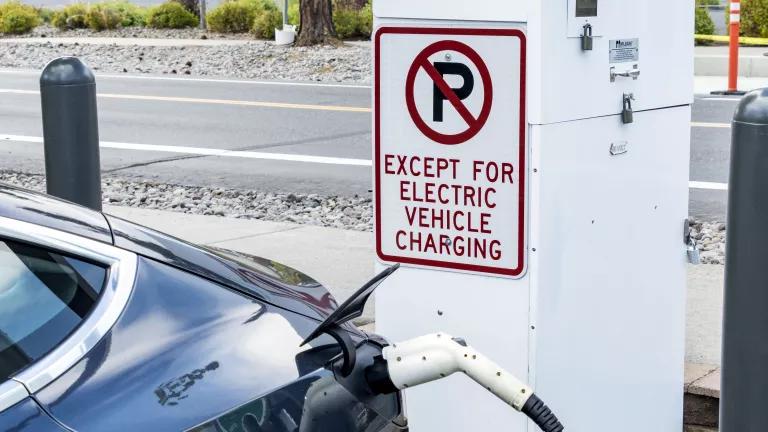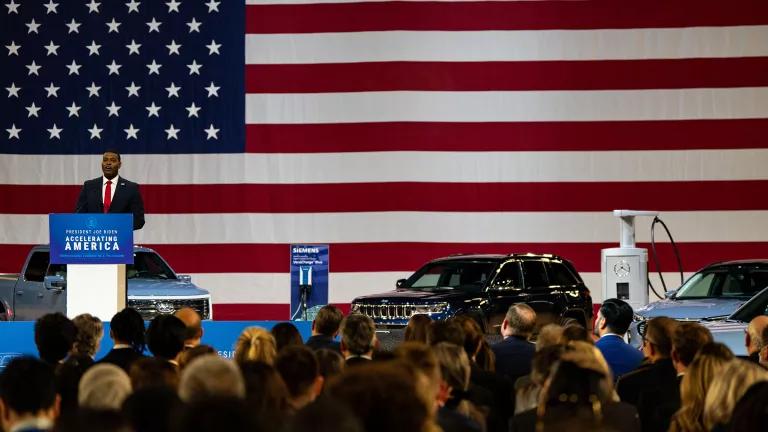Automakers Try to Dodge Their EV Commitments
Despite claims to support electric vehicles, automakers are attempting to thwart new federal standards that would accelerate the transition to clean transportation.

A car plugged into one of 44 electric vehicle charging stations on Oregon's West Coast Electric Highway
Oregon DOT
Automakers are trying to have it both ways. If you have seen any car commercials or paid attention to automakers’ public pronouncements in recent years, it sure sounds like they are all in on electric vehicles (EVs). However, contrary to their public commitments and snazzy commercials, automakers are trying to head off new federal standards that could bring about the transition to EVs that they are claiming to support.
It makes no sense. Some automakers say that the U.S. Environmental Protection Agency’s (EPA) new tailpipe emissions standards are “not achievable or feasible”—even though many of the car companies’ own public commitments were incorporated by the EPA in its proposed standard.
Automakers can’t have it both ways: If they are serious about their pledges to make this transition, there’s absolutely no reason to object to these commonsense proposed standards. And given the climate crisis that’s on full display this summer, we can’t afford to let automakers’ double-talk carry the day.
The EPA’s proposal
The EPA has proposed tailpipe emission standards for passenger cars and trucks that will reduce pollution from new vehicles by about 56 percent in 2032 compared to 2026 levels. While the EPA does not require this level of stringency to be met by any specific technology, the EPA is estimating that car companies will achieve the requirements most cost-effectively by increasing the number of electric vehicle sales; it projects that about two-thirds of new vehicle sales in 2032 will need to be zero-emission cars and trucks.
Many automakers are complaining that this target is bolder than the one of 50 percent zero-emission vehicle (ZEV) sales by 2030 that President Biden announced in 2021. It is, and for a good reason: The 2021 target was set before the passage of the Inflation Reduction Act and Bipartisan Infrastructure Law—major climate investments that will not only help to reduce the price tags of vehicles but also help kick-start a robust network of charging infrastructure throughout the United States. An analysis by the International Council on Clean Transportation shows that these investments, along with the adoption of the Advanced Clean Cars II policy in a number of states, mean that, by 2030, the United States will already be at 48 to 61 percent zero-emission new vehicle sales.
The EPA’s regulations are not meant to keep things business as usual but to instead help accelerate the transition toward cleaner, less polluting vehicles.
Automaker investments
Carmakers have already invested more than $210 billion in the transition to ZEVs in the United States. The Alliance for Automotive Innovation (the trade group that represents all major traditional automakers such as General Motors, Nissan Motor Company, Ford Motor Company, and Stellantis) stated that the car industry plans to invest another $1.3 trillion toward ZEVs by 2030. And every automaker has made some kind of pledge about ramping up EV sales.
But here’s the kicker: The commitments for EV electrification were all made prior to the Inflation Reduction Act becoming law. This historic climate package provides unprecedented support to help build out the EV supply chain in the United States and helps consumers afford new or used electric vehicles. Analysts predict it will provide a huge boost to EV sales.
The combination of industry trends and the Inflation Reduction Act is driving the transition to cleaner vehicles. The EPA’s standards are just the icing on top, ensuring that automakers really deliver on the carbon reductions they have promised—which we all need.
The automaker comments
Despite their public promises, automakers are raising alarm bells in the media, claiming that the EPA regulations are unfeasible. This is echoed strongly in the Alliance for Automotive Innovation’s comments to the EPA.
For example, GM—which has a goal of 100 percent zero-emission vehicles by 2035—wants the EPA to not go beyond President Biden’s executive order of 50 percent EV sales in 2030.
Some automakers are conveniently ignoring their previous commitments to ZEV transition. Nissan announced in 2021 that it would have 100 percent zero-emission vehicle sales by the “early 2030s,” but in its comments to the EPA, it only acknowledged aiming for 40 percent by 2030.
Meanwhile, some companies are saying that their public pronouncements shouldn’t be taken seriously. Honda said, “It is important that the agencies not approach such…announcements as foregone conclusions.”
Toyota submitted the most robust individual comments from car companies; yet despite its claim to have the “most electrified vehicles,” on the road, Toyota’s comments unfortunately align with its slow pace toward bringing more EVs onto the roads. Toyota does have a robust lineup of traditional hybrid vehicles (i.e., vehicles that do not plug into an external battery source to recharge), but only two plug-in hybrid options and one fully electric option (compared to GM’s eight zero-emission models). The hybrid vehicles are technically electrified but do not maximize the climate benefits like plug-in hybrids or battery electric vehicles do.
Stellantis calls the EPA’s proposal an “overly optimistic expectation for EV market growth,” despite its own stated commitment to achieving 100 percent EVs in Europe by 2030, as well as its goal to becoming carbon net zero by 2038. And after the announcement of the Advanced Clean Cars II regulation, Stellantis stated that its commitments to vehicle electrification “support the ACC II rule”—which only has a sales requirement of 68 percent ZEVs in model year 2030.
However, Ford—a member of the Auto Alliance—is supportive of the EPA’s proposal.
In its comments to the EPA, Ford stated that it “supports the 2032 endpoint of the multi-pollutant proposal, which may result in approximately 67 percent of new light- and medium-duty vehicles being [zero-emission vehicles].” It continued: “Ford is all in on electrification. We are investing more than $50 billion through 2026 to deliver breakthrough electric vehicles (EVs) and reach a global run rate of 600,000 EVs a year by the end of this year and 2 million in 2026.”
And while the Auto Alliance headlined its blog “EPA's EV Rules Are Out of Whack,” its comments are more muted. It’s asking the EPA to adopt its “Alternative 3” proposal, which is a more linear ramp to a 56 percent emission reduction by 2032. Same goal; different path. Maybe the blog should read, “EPA’s EV Rules Need a Subtle Adjustment”?
Pathways to compliance
It’s important to underscore a previous point: Under the proposed EPA standards, there is no requirement that automakers sell a certain number of electric vehicles—despite what car companies are claiming in media headlines.
Car companies can achieve these improvements through whatever pathway they see as being the most cost-effective. But since they have made so many public announcements about being all in on electrification, this seems to be a natural pathway. For example, focusing sales on the cleanest trims of vehicles can provide significant fleet emission savings. Additionally, automakers can achieve compliance by selling plug-in hybrid vehicles and other vehicles with smaller footprints.
What they cannot do is to keep selling polluting, gas-guzzling SUVs and pickup trucks; we need gas vehicles to get much cleaner, along with more ZEVs on the road. Automakers will need to make improvements and cut tailpipe pollution somehow—and history shows that once stronger, more protective standards are in place, companies innovate and comply. Over the past decades, automakers have fought regulations that make our world cleaner and safer, but when they put their engineers to work, the products have been better for consumers and the environment.
The future is electric
The fact is, the future is now, the transition is underway, and it is electric. Automakers have made commitments to not only electrify vehicles here in the United States but are moving toward 100 percent zero-emission vehicle sales in Europe in an even shorter time frame.
So, automakers have an important choice—to live up to their public commitments or to try to obfuscate and delay. Consumers are snapping up EVs, and charging stations and other network investments are in place. Automakers are saying the right thing, but behind the scenes, it’s time for them to get into the driver’s seat and actually hit the accelerator on the road to a climate-safe future.




